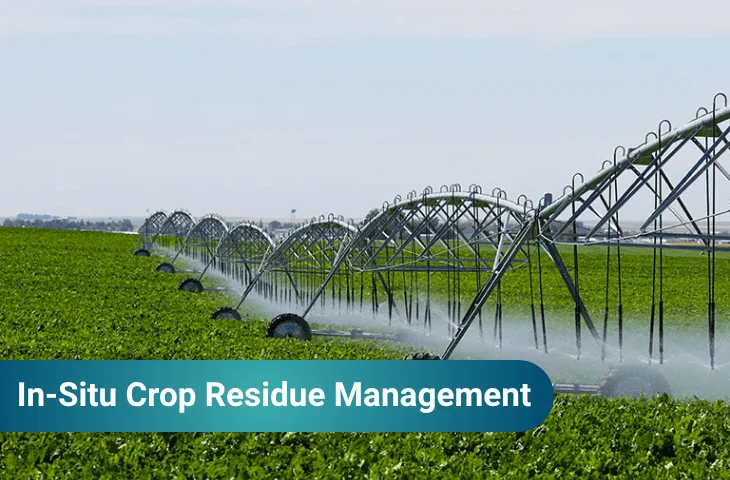The “Promotion of Agriculture Mechanization for In-Situ Management of Crop Residue” is a central government initiative under the Sub-Mission on Agricultural Mechanization (SMAM). The scheme primarily focuses on providing financial assistance to farmers for the purchase of modern machinery to manage crop residue in-situ, that is, directly in the field, rather than burning it.
Launched initially for the period 2018-19 to 2019-20 in the states of Punjab, Haryana, Uttar Pradesh, and the National Capital Territory of Delhi, the program targets the critical issue of air pollution caused by stubble burning and promotes sustainable agricultural practices.
This initiative encourages the creation of Farm Machinery Banks (FMBs) or Custom Hiring Centres (CHCs), ensuring that even small farmers can access expensive equipment through shared usage.
Why is In-Situ Crop Residue Management Important?
Stubble burning has become a severe environmental and agricultural problem in India, particularly in the northern states. The process of burning crop residue releases:
- Particulate matter (PM)
- Carbon monoxide (CO)
- Carbon dioxide (CO₂)
- Sulfur dioxide (SO₂)
- Ash
These pollutants significantly deteriorate air quality, aggravating respiratory, skin, and eye diseases.
Apart from air pollution, stubble burning also:
- Destroys soil nutrients and microorganisms
- Alters soil properties such as temperature, pH, moisture, available phosphorus, and soil organic matter
- Reduces long-term soil fertility and productivity
By promoting in-situ crop residue management, the scheme addresses these environmental and agricultural challenges while encouraging sustainable farming practices.
What are the Objectives of the Scheme?
The scheme has been designed with multiple objectives aimed at environmental protection, sustainable agriculture, and rural development. Key objectives include:
| Objective | Details |
| Reducing Air Pollution | Prevent the release of harmful gases and particulate matter caused by stubble burning. |
| Preventing Loss of Soil Nutrients and Microorganisms | Maintain soil fertility and promote healthy soil ecosystems by integrating crop residue into the soil. |
| Promoting In-Situ Management of Crop Residue | Encourage the use of mechanization inputs such as Happy Seeders, Rotavators, Super SMS, and Mulchers for effective residue management. |
| Establishing Farm Machinery Banks/Custom Hiring Centres | Facilitate access to machinery for small farmers who cannot afford expensive equipment individually. |
| Creating Awareness among Stakeholders | Conduct demonstration camps, capacity-building programs, and education campaigns to encourage proper crop residue management practices. |
What are the Benefits of the In-Situ Management of Crop Residue?
The scheme provides financial assistance to different stakeholders:
| Beneficiary | Financial Assistance | Purpose |
| Individual Farmers | 50% financial assistance | For purchasing machinery required for in-situ management of crop residue. |
| Farmers’ Groups and Cooperatives (including FPOs, women’s groups, and private entrepreneurs) | Up to 80% financial assistance | For establishing Farm Machinery Banks (FMBs) or Custom Hiring Centres (CHCs) to provide machinery on rent. |
| State and Central Agencies (State Governments, KVKs, ICAR institutions, Central Govt. institutions) | Funding support | For Information, Education, and Communication (IEC) activities such as mass awareness campaigns, training programs, demonstrations, and awards for zero stubble burning villages. |
What Machinery is Covered under the Scheme?
The scheme supports the procurement of modern machinery that helps in in-situ crop residue management. Key equipment includes:
- Super Straw Management System (SMS) – for combine harvesters
- Happy Seeder – for sowing wheat directly into paddy residue
- Hydraulically Reversible MB Plough
- Paddy Straw Chopper/Shredder
- Mulcher
- Zero Till Seed Drill
- Rotavator
- Super Seeder
These machines not only help in residue management but also improve soil health and farm productivity.
Check Out: Complete List of Important Schemes for NABARD Grade A Exam
How is the Scheme Implemented?
The implementation of the scheme involves multiple stakeholders:
- State Governments – responsible for facilitating procurement and promoting awareness.
- Krishi Vigyan Kendras (KVKs) – provide technical support, training, and demonstrations.
- ICAR and Other Central Institutions – assist in research, technical guidance, and capacity building.
- FPOs and Cooperatives – operate Farm Machinery Banks/CHCs to ensure machinery is accessible to small farmers.
Financial assistance is provided for machinery procurement, establishing CHCs, and IEC activities. This ensures a holistic approach toward environmental protection, sustainable farming, and farmer empowerment.
How does the Scheme Benefit Farmers Economically?
This scheme benefit farmers economically in various ways such as :
- Lower Machinery Cost – Farmers get financial support and access to machines through CHCs, reducing the burden of buying costly equipment.
- Better Crop Yield – Managing crop residue in the field improves soil health and leads to higher productivity in the next season.
- Income Opportunities – Custom Hiring Centres (CHCs) create chances for local entrepreneurs and farmers to earn by renting out machines.
- Eco-Friendly Farming – Encourages sustainable practices, improves soil fertility, and reduces dependence on chemical fertilizers.
Get ready to crack government job exams with leading educators
How does the Scheme Address Environmental Concerns?
The scheme addresses the environmental concerns in several ways, such as:
- Reduction of Air Pollution: In-situ crop residue management eliminates the need for stubble burning, significantly reducing particulate matter and harmful gases.
- Soil Enrichment: Crop residues are incorporated back into the soil, adding organic matter and preserving nutrients and microorganisms.
- Climate Benefits: Reducing stubble burning lowers carbon emissions, contributing to climate change mitigation.
- Promotes Sustainable Practices: Encourages the adoption of modern machinery and conservation agriculture techniques, fostering environmentally responsible farming.
What IEC Activities are Promoted Under the Scheme?
The scheme includes IEC initiatives to educate farmers and stakeholders on the importance of in-situ crop residue management:
- Demonstration Camps – showcasing machinery and proper residue management techniques.
- Capacity Building Programs – training farmers on sustainable agricultural practices.
- Awareness Campaigns – educating communities on environmental and health impacts of stubble burning.
- Awards and Incentives – recognizing villages and groups achieving zero straw burning.
These activities help create awareness and encourage widespread adoption of the program.
Why is the Scheme Relevant for Government Exam Aspirants?
For aspirants preparing for UPSC, State PSCs, and other government exams, this scheme is highly relevant due to its:
- Environmental focus – aligns with questions on pollution, climate change, and sustainable agriculture.
- Agricultural innovation – connects with topics on farm mechanization, crop residue management, and rural development.
- Government initiatives – part of central sector schemes and Sub-Mission on Agricultural Mechanization (SMAM).
- Socio-economic impact – highlights financial assistance, rural entrepreneurship, and capacity building.
Understanding this scheme equips aspirants with knowledge applicable to GS Paper 3 (Agriculture, Environment, and Economy).
Also Check: List of Government Schemes of India
Key Takeaways
| Aspect | Key Points |
| Scheme Name | Promotion of Agriculture Mechanization for In-Situ Management of Crop Residue |
| Launch Period | 2018-19 to 2019-20 (initially) |
| Implementing Authority | Sub-Mission on Agricultural Mechanization (SMAM) |
| Beneficiaries | Individual farmers, FPOs, cooperatives, women’s groups, private entrepreneurs |
| Financial Assistance | 50% for individual farmers, 80% for CHCs/Farm Machinery Banks |
| Key Machinery | Happy Seeder, Super SMS, Rotavator, Zero Till Seed Drill, Mulcher |
| Objectives | Reduce air pollution, improve soil health, promote sustainable agriculture, create CHCs |
| IEC Activities | Demonstrations, training, awareness campaigns, awards |
| Environmental Benefits | Reduced stubble burning, nutrient retention, climate change mitigation |
| Economic Benefits | Lower machinery costs, increased productivity, local entrepreneurship |
Questions Based In-Situ Crop Residue Management
- When was the “Promotion of Agriculture Mechanization for In-Situ Management of Crop Residue” scheme initially launched?
A) 2015-16
B) 2016-17
C) 2018-19
D) 2020-21
E) 2017-18 - Under which sub-mission is the scheme implemented?
A) Rashtriya Krishi Vikas Yojana
B) Sub-Mission on Agricultural Mechanization (SMAM)
C) National Mission on Sustainable Agriculture
D) Pradhan Mantri Fasal Bima Yojana
E) Atal Bhujal Yojana - Which states were covered in the initial launch of the scheme?
A) Punjab, Haryana, Uttar Pradesh, Delhi
B) Maharashtra, Gujarat, Rajasthan, Punjab
C) Bihar, Jharkhand, West Bengal, Odisha
D) Karnataka, Tamil Nadu, Kerala, Andhra Pradesh
E) Madhya Pradesh, Chhattisgarh, Uttar Pradesh, Bihar - What percentage of financial assistance is provided to individual farmers for machinery procurement?
A) 100%
B) 75%
C) 60%
D) 50%
E) 40% - Which of the following machines is covered under the scheme?
A) Happy Seeder
B) Tractor-Trolley
C) Laser Leveler
D) Sprinkler System
E) Drone
Also Read:
- What is the primary environmental objective of the scheme?
A) Increase irrigation coverage
B) Reduce stubble burning and air pollution
C) Promote organic fertilizers
D) Improve marketing of crops
E) Enhance crop insurance coverage - Who can establish Farm Machinery Banks (FMBs) or Custom Hiring Centres (CHCs)?
A) Only individual farmers
B) Only government agencies
C) Farmers’ groups, cooperatives, FPOs, women’s groups, private entrepreneurs
D) Multinational companies
E) Only state governments - Which organization supports implementation through technical guidance and capacity building?
A) NABARD
B) ICAR and KVKs
C) NITI Aayog
D) Ministry of Finance
E) SEBI - What is the significance of IEC activities under this scheme?
A) Only financial audits
B) Mass awareness, training, demonstration, awards
C) Land acquisition
D) Crop insurance processing
E) Market linkage - How does in-situ crop residue management benefit soil?
A) Depletes nutrients
B) Increases erosion
C) Preserves nutrients and organic matter
D) Increases pH drastically
E) Reduces water retention
Answer Key
| Question Number | Correct Answer |
| 1 | C) 2018-19 |
| 2 | B) Sub-Mission on Agricultural Mechanization (SMAM) |
| 3 | A) Punjab, Haryana, Uttar Pradesh, Delhi |
| 4 | D) 50% |
| 5 | A) Happy Seeder |
| 6 | B) Reduce stubble burning and air pollution |
| 7 | C) Farmers’ groups, cooperatives, FPOs, women’s groups, private entrepreneurs |
| 8 | B) ICAR and KVKs |
| 9 | B) Mass awareness, training, demonstration, awards |
| 10 | C) Preserves nutrients and organic matter |
- JAIIB RBWM Exam 2025 Analysis 16th November 2025
- SEBI Grade A Vacancy 2025 Revised, Stream Wise Past 5 Years Vacancies
- IFSCA Grade A Exam Analysis 2025, Phase 2, 15 November 2025
- Structure & Functions of RBI, Organisational Structure of RBI
- Bank of India SO Salary 2025, Pay Scale, Benefits & Growth
- Bank of India SO Syllabus 2025, Exam Pattern, Marking Scheme

Hi, I’m Aditi. I work as a Content Writer at Oliveboard, where I have been simplifying exam-related content for the past 4 years. I create clear and easy-to-understand guides for JAIIB, CAIIB, and UGC exams. My work includes breaking down notifications, admit cards, and exam updates, as well as preparing study plans and subject-wise strategies.
My goal is to support working professionals in managing their exam preparation alongside a full-time job and to help them achieve career growth.
